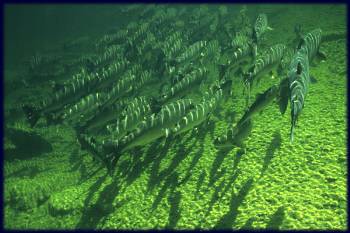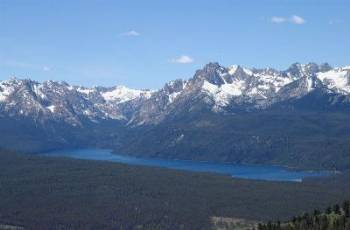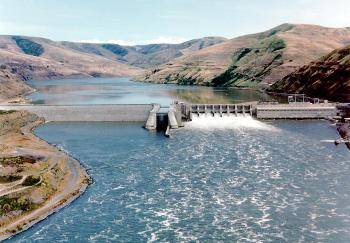forum
library
tutorial
contact

Salmon Plan Disappoints Fish Advocates
by Gary StiversSun Valley Online, September 7, 2007
|
the film forum library tutorial contact |

|
Salmon Plan Disappoints Fish Advocatesby Gary StiversSun Valley Online, September 7, 2007 |

A science panel drawn from operators of the Columbia River hydroelectric system Thursday released a draft biological assessment on salmon recovery which includes what they call an all-new salmon recovery plan which advocates say looks awfully familiar.
The National Oceanic and Atmospheric Administrationwill have to approve this latest plan to save endangered salmon in Idaho -one required by a federal judge. Bill Sedivy with Idaho Rivers United says the list of actions to restore river health and fish populations still places heavy emphasis on barging fish around dams and manipulating river flows to benefit fish migration.
Sedivy says some of the new ideas are pretty good, but the central functions of the plan are the same as the previous plan's -and several iterations well before that.
"They've maybe wrapped it in prettier bows," Sedivy pans, "but it's the same old stuff that's been tried and has failed."
U.S. District Judge James Redden for the District of Oregon required the new plan because the old one didn't consider all the scientific options on the topic - including one that removes four dams on the Lower Snake River. Sedivy says the "new" plan also doesn't include that option. He says if the plan is adopted by the agency in charge of fish, another lawsuit is likely.
"I don't know how they can continue to do that," Sedivy told SVO. "We had four sockeye return to Redfish Lake this year, just four, where hundreds of thousands once returned to spawn."
 Origins
Origins
SVO asked Sedivy to describe the origin of Thursday's biological opinion and what comes next.
"How this works is, the action agencies, the people who actually run the hydro system -BPA, the Army Corps of Engineers and Bureau of Reclamation- put together the biological assessment," Sedivy explained. "What the assessment is supposed to do is evaluate the impacts of the proposed actions, how the operations of the hydro system will impact the endangered species. The agency responsible with species like grizzlies and polar bears. It's NOAA's job to take look at proposed actions."
Sedivy cited a disturbing incestuousness about that process.
"They're in cahoots and have been working together on the plan from start to finish," Sedivy notes. "There's little reason to suspect NOAA will do anything other than approve it."
The process now
Sedivy said NOAA has a very short window in which to accept or reject the plan.
"It's supposed to be done by Oct 31st. That seems a tight time frame but the opinion's been in the works for two years since the decision of the federal court."
We asked Sedivy whether he feels Idaho Rivers or the six-million-member Save Our Wild Salmon organization have any chance at all of making meaningful changes in the plan before the Bush Administration adopts it.
"Unfortunately, I think the Bush Administration and the political appointees they put at head of agencies like NOAA and the Bonneville Power Administration will perform as they always have," Sedivy predicted. "Their primary desire is to protect the status quo. It will take incredibly strong congressional leadership to move [the administration] off of the unfortunate platform they've adopted, which more or less assures a path to extinction."
Sedivy said there's no reason to expect the new plan will ever get the anadromous fish back to sustainable numbers.
"The plan released [Thursday] reflects 30 years of failed practices," Sedivy asserts. "We've had four sockeye return to Redfish [Lake] this year and fewer than 4,000 wild Chinook compared with eight- to 16 million that were estimated to have made the run before Europeans arrived in the Northwest."
 Sedivy said no reasonable environmentalist really expects to restore pre-Columbian numbers in our lifetimes, but getting back to recent history is a good target and one the 'new plan' doesn't propose to reach.
Sedivy said no reasonable environmentalist really expects to restore pre-Columbian numbers in our lifetimes, but getting back to recent history is a good target and one the 'new plan' doesn't propose to reach.
"Even as of the late 1960s and after all the damage done by the mining and logging and dams, etc, we still had close to 200,000 Chinook returning to the Snake River Basin. Nobody's suggesting going back to the pre-human levels, but to restore the sockeye and Chinook, we need to bring back enough fish to be self-sustaining. There isn't a precise number there, but most agree it's something like the 200,000 we've seen recently and -importantly - keeping the ecosystem healthy."
Friends (and others) in arms
As for the effort nearest to hand, Sedivy said Idaho Rivers United, which co-founded Save Our Wild Salmon, will work with anyone and everyone.
"We work with anybody," Sedivy proclaims, "be they farmers, fishers, governments, anybody who'll demonstrate a willingness to work with [the goal of sustainable populations]. The Columbia River Treaty Tribes including the Nez Perce are good examples. Under treaties, they have the right to fish and they're working with us."
Elected officials willing to help restore the endangered fish are harder to find, Sedivy said.
"The most sympathetic state government over last the last five years has been the State of Oregon," Sedivy calculated. "We worked with them under former Governor Kitzhaber and now under Governor Ted Kulongoski. The State of Washington under Governor Christine Gregoire has been extremely disappointing. Their only focus seems to be the Columbia River."
 Sedivy asserts the biggest political challenges have arisen in his home state.
Sedivy asserts the biggest political challenges have arisen in his home state.
"[Senator Larry] Craig has been involved big with hydropower and all associated industries and is really the chief spokesman with the anti-salmon crowd," Sedivy stated. "If his current troubles remove him from office or diminish his influence, we may do better, but I don't have high hopes. With him home gone, we do have an opportunity, but [Governor Butch] Otter isn't likely to appoint an environmentalist."
A shocker for sockeye supporters
Sedivy said there's a shocking note about sockeye recovery in the new plan:
"One of the real tragedies of the plan released yesterday is, in my view, it writes off the sockeye," Sedivy despaired. "They are proposing doubling the life support hatchery effort which in itself is a good thing, but in their assessment, they say they're not sure it will work and they say there's nothing else they can do."
Sedivy thinks the assessment may not go very far before Judge Redden takes a look.
"The fact that Redden took his earlier stand, I hope he's appropriately livid at this," Sedivy opined. "It's essentially the same old crap with new ribbons and bows. I don't think the judge will warm to it very well."
learn more on topics covered in the film
see the video
read the script
learn the songs
discussion forum
